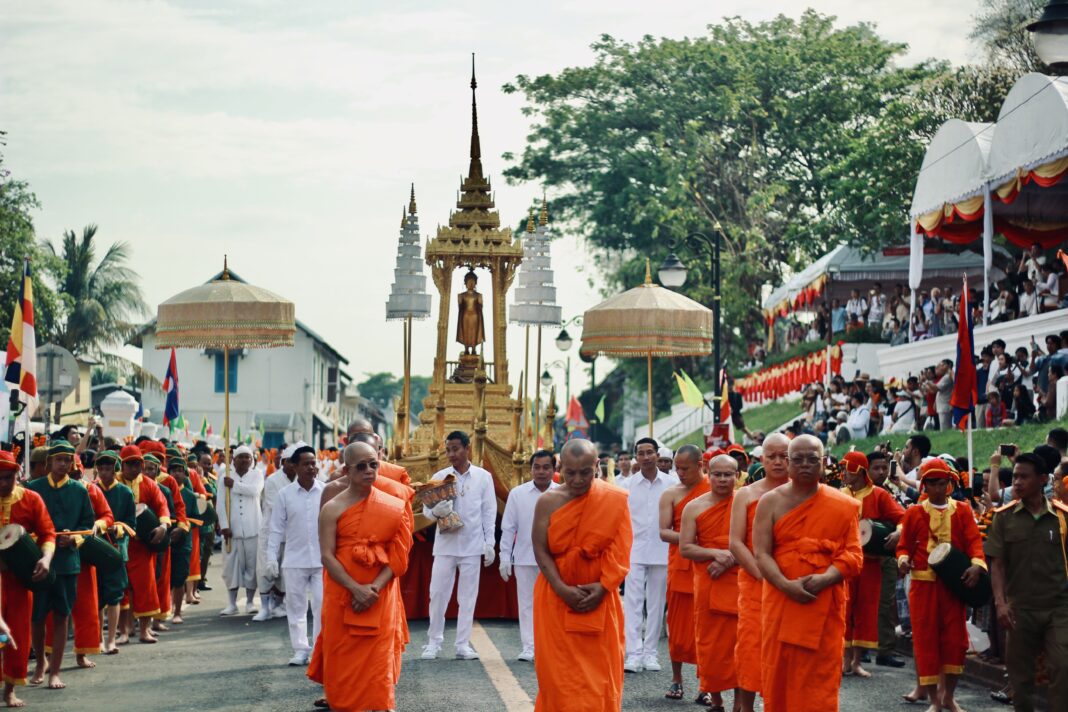This morning, Luang Prabang awoke to the sounds of drums, chanting monks, and crowds of locals and visitors dressed in their finest traditional Lao clothing.
It’s 17 April, and one of the most revered moments of Pi Mai—the Lao New Year—is taking place: the sacred procession of the Prabang, the Buddha image for which Luang Prabang is named.
Monks and city leaders carried the statue from its shrine in the Ho Prabang, located within the former Royal Palace grounds, to Wat Mai Temple, where it will remain for three days.
During this time, people from across the country will come to pour water over the statue, a ritual known as song nam phra, to show respect and ask for blessings for the year ahead.

The Prabang, cast from a sacred mix of bronze, silver, and gold, stands 83 centimeters tall and weighs 43 kilograms. The Buddha is shown in the Abhayamudra, or “Dispelling Fear,” posture—hands raised, palms forward, offering peace and protection.
Though legend traces the statue’s origin to Sri Lanka, scholars believe it was made in the Khmer Empire.
Chronicles tell of its arrival in the Lao kingdom of Lan Xang in the 1350s, carried from Angkor in a grand procession led by the Khmer princess Keo Keng Nya, who had married King Fa Ngum.
The statue’s journey wasn’t smooth. Though it was meant for Xieng Thong (now Luang Prabang), it remained for a time in Vientiane, believed to be too heavy to carry further.
It was finally brought north in 1502 by King Visoun and placed first in Vat Manorom, then in Vat Visoun, built especially for it.
Over the centuries, the Prabang was moved, captured, and returned—including two periods of exile in Bangkok—before it was finally reinstalled in Laos in 1867.
It has been housed in the Ho Prabang shrine since 2013, but is brought out only once a year, for Pi Mai.

Why 2025 Is Also 2568 and 1387
While much of the world celebrates the new year on 1 January, Lao New Year follows a different system—one that’s based on more than one calendar.
Pi Mai usually takes place from 14-16 April, but its meaning runs deeper than just those three days. It marks a spiritual transition from the old year to the new, observed with cleansing rituals, ceremonies, and celebrations across the country.
This year, the internationally used Gregorian calendar calls it 2025. But Laos observes two distinct calendars: the Chula Sakkharat and the Buddhist Era (B.E.) calendar, each marking the New Year on different dates and based on different astronomical principles.
The Chula Sakkharat calendar begins from the year 638 CE. This is a solar calendar that determines the New Year when the Sun enters Aries, typically around 16 April. This date marks the beginning of the solar year and is based on the Earth’s orbit around the Sun.
Historically, this calendar was also used in Thailand until it was replaced by the Buddhist Era calendar in 1889. By that count, this year is 1387.
In contrast, the Buddhist Era calendar is a lunisolar system that incorporates both lunar cycles and the solar year. The New Year in this calendar falls on the full moon day in May, aligning with the Visakha month. This date commemorates significant events in the life of the Buddha, including his birth, enlightenment, and death.
The Buddhist calendar conventionally begins in 543 BC, which is believed to be the year the Buddha passed away. According to this system, 2025 is the year 2568.
Depending on which calendar is being used, the Lao New Year in 2025 can be called either the year 1387 (Chula Sakkharat) or 2568 (Buddhist calendar).
Happy Pi Mai Lao 2568—or 1387!



